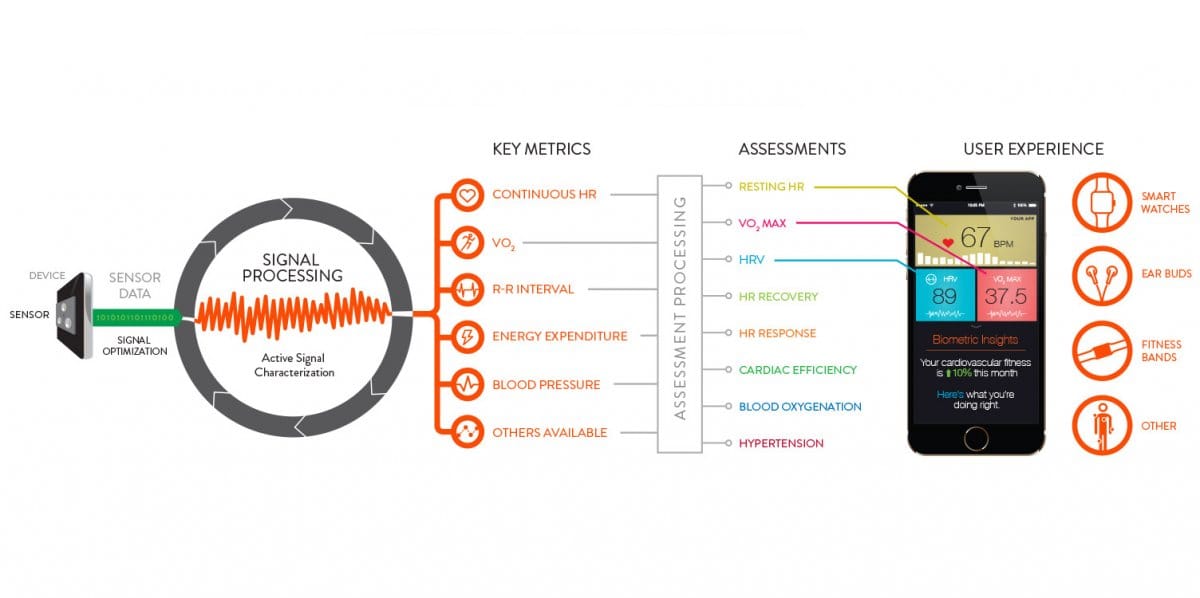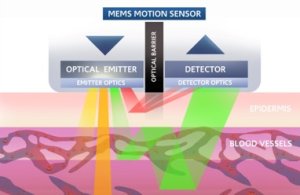How Accuracy Happens in Biometric Wearables
Let’s talk about how accuracy in biometric wearables actually happens. Specifically, how does shining light into a person’s body and detecting the scattered light (a methodology known as PPG) result in an accurate indication of your blood flow properties, such as heart rate or blood pressure, in real-time on the screen of your favorite wearable device or mobile fitness app? The process of making PPG accurate in wearables has been a mystery to the general public, and even to many veterans in the wearables and hearables industry. We’ve written about many of the before, so let’s look at how the technology works and how state-of-the-art technology can be applied towards accurate biometric wearables.
How Biometric Wearable Technology Works
The diagram below shows the process from when scattered light is collected by the optical sensor that sits against your skin, through data processing, data analysis, and visualization via a user experience of some kind – on a wearable device screen, on a mobile app, or some other interface. You can think of each of these steps as important links in a chain and the phrase “you are only as strong as your weakest link” absolutely applies to biometric wearables. It’s critical to get all of them right to achieve sufficiently accurate, useful data.
“You are only as strong as your weakest link in biometric wearables.”

Biometric Sensors
This is where the sensors meet the skin. Most optical sensor systems include optical emitters to shine the light, optical detectors to measure how much light bounces back from the body, and some include an accelerometer to detect motion during measurement. The process looks something like this:

The optomechanics of the sensors, the light guiding, and the geometry of their placement are critical for clean signal processing. There are a few key aspects of biometric sensors that have a huge impact on the accuracy of these devices, including the:
•Number and position of the optical emitters – most sensor systems use 2 or 3 optical emitters. More emitters enable multiple colors, wavelengths, and more opportunities for characterizing physiological and motion information. The geometric positioning of the emitters to the detectors must be optimized in context of the complete sensor system.
•Angles of the light emitters and detectors – as little as a fraction of a degree difference in the angles of the emitters and detectors in the device can also have meaningful impacts on accuracy, and the optimum angles depend on the sensor location along the body.
•Wavelengths of light used – depending on the sensor location along the body, it may be best to use visible light or infrared light.
How the sensor fits on the human body (known as “coupling”) is also very important, and this obviously varies by where the device is worn. For example, the biometric sensors in earbuds have very different coupling considerations than a smart watch, because ears are 3-dimensional and must account for a large variety of shapes and sizes of human ears to stay in the right position during activity. Wrist-based devices are positioned on a relatively flat, 2-dimensional surface where other factors come into play, such as the optical “shadow” created on the wrist by the device itself.
The Trade-offs
Clearly there are trade-offs that are made between size, comfort, and accuracy of a biometric sensor system when it comes to these factors, particularly when you are trying to support usage during activity – lifestyle activities, running, working out, etc. You can make the sensor system smaller to reduce the size of your wearable device, but you may sacrifice accuracy. You can make the sensor system slightly larger to perhaps improve accuracy and to enable better user experiences and more powerful use cases, but this has an impact on the overall size of the device.
Sensor data
The raw sensor data must be processed by an algorithm to identify the heart rate and other biometrics. No matter how good the optomechanics of your biometric sensors are, when you shine light into a person’s skin only a small fraction of the light returns to the sensor. In fact, of the total light collected by the optical detector, only ~1/1000th of it may actually indicate heart-pumped blood flow.
Signal processing
Every biometric sensor system has algorithms to process the 1’s and 0’s into biometrics, but not all algorithms are created equal. Many wearables on the market today do a decent job of measuring heart rate at rest. In fact, this technology has been around for decades and the finger or ear clips in healthcare facilities are still used to measure your pulse during rest. However, as soon as you start moving, the signal quickly gets corrupted because the sensor generates more motion noise than blood flow signal (the signal that contains heart rate information). Moreover, the process is further complicated during motion in a changing light environment, such as when jogging through shadows. This is because the time-varying changes in sunlight intensity are so much stronger than the tiny blood flow signal intensity that the signal processing can be overwhelmed with erroneous data. The challenge for wearables is making this technology motion-tolerant.
The key is a process known as Active Signal Characterization (ASC), a real-time process which actively characterizes raw signal data from biometric sensors into biological, motion, and environmental signals.. ASC then actively removes the appropriate motion and environmental signals in the context of physiological models and keeps the relevant blood flow and activity signals for signal processing. The result is a clean PPG signal that contains cleaner information about blood flow and other characteristics. Because blood flow modulates with heart rate and respiration rate, sensor systems that use ASC can accurately extract continuous heart rate, RR-interval, respiration rate, and other blood flow parameters from the photodetector signal even during intense exercise.
Once accurate biometrics are generated, these measurements can be used by a mobile application to generate health and fitness assessments (see below). As with any other sensor system, no matter how good the sensor configuration or signal processing, there will always be some data collected that is simply erroneous. Unfortunately, when biometric data is used by a mobile application to generate a health or fitness assessment, the criteria for accuracy is quite strict. Just a few BPM difference in heart rate or a few milliseconds difference in RRi can destroy the usefulness of a health or fitness assessment. For this reason, the most advanced sensor systems available today provide what are known as “signal quality flags”, generated via signal processing, to indicate the quality of the biometric data and to inform the mobile application to exclude low-quality data.
Key metrics and assessments
Biometric measurements — such as continuous heart rate, VO2, R-R interval (RRi), blood pressure, and more — are the output from the signal processing algorithms. These are the foundational metrics that support the vast majority of use cases in wearables today.
Key metrics like these can also serve as inputs for further analysis and derivative assessments that support even more compelling user experiences in biometric wearables. Some assessments include cardiac efficiency, resting heart rate, heart rate recovery, VO2 max, heart rate variability, hypertension, and many more. However, it’s important to understand that you must start with a highly accurate PPG signal and processing in order to provide any level of accuracy in derivative metrics or assessments. For example, if the foundational metric like heart rate is inaccurate, you will never get more advanced metrics like R-R interval or blood pressure.
User Experience
All the compelling user experiences being discussed in the marketplace today demand accurate assessments generated by accurate biometrics. Consider the use case where a mobile app, in communication with your biometric wearable, is able to predict the onset of illness days before you actually feel sick. Imagine the increase in productivity you’d experience by frontloading work or fun (ahead of symptoms) and preparing for future resting time. Similarly, consider the use case where a cloud application, in communication with your biometric wearable, is able to tell you the optimum amount and timing of exercise, personalized to your unique physiology, to train you to peak performance in a marathon.
These intriguing use cases, along with many others, have already been proven by researchers in the field using uncomfortable benchmark devices (such as chest straps and VO2 masks), and the limiting factor to mass adoption has been accurate, comfortable biometric wearables. With the advent of accurate biometric wearables, we are seeing these devices and experiences come to market now with many more in the works.
Regardless of use case, the next generation of biometric wearables will be driven by proactive recommendations and guidance for users, which requires highly accurate data and assessments for products and promises that users can believe in. In part 3 of this series, we’ll explore the important factors in getting highly accurate wearables to market.